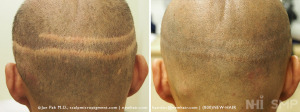Hi Dr.Rassman,
I’d be very grateful if you could reply to the following questions:1. How do the technicians slivering the donor strip record the Follicular Units. Is this done as a running total on a sheet of paper for type 1, 2, 3 units? Is the total of these units then recorded?
2. How do the placers, placing the Follicular Units record the Incisions created. Is this similar to Q.1 above.
3. Is it true that each incision site created can only contain ONE Follicular Unit graft? Otherwise, more than one would be compressed, traumatized and die??
4.If the Incision count is LESS than the Grafts extracted from the donor strip, what would that indicate.
5. What would increase a hair transplant procedure between 2 patients having the same amount of grafts transplanted and the same number of medical staff in attendance? For example, if one of the patients had blond hair, would it be more difficult to see such grafts under a stereomicroscope?
I often get these type of questions asked in different ways. It is a very good question that also can be seen as a trust between doctor and patient. In other words, how do you know if you are receiving the number of grafts agreed up on (which relates to how much you paid for).
It is also a great question merely from purely a technical point of view of how one keeps track of thousands of grafts and incisions on one’s head.
I cannot speak for all the hair transplant doctors in the world as there is no standardization on how one keeps track of grafts. I will try to explain your question from a general perspective as well as what I personally have been doing in my practice for the last 23+ years.
1. Our staff keeps track of each graft dissected on a paper as they cut about 25 to 50 grafts at a time. They record and sort out single hair to multiple hair grafts individually as they dissect the grafts. A team leader then double checks the numbers as the day progress and add up the total number of grafts on a master sheet. Finally when all the grafts are dissected, another accounting in made on a computer Excel spread sheet. Usually we double check numbers with another staff individually adding up the numbers separately.
2. The placers do not keep track of the grafts being placed. Instead the doctor keeps track of how many incisions were made. If there was 1000 grafts cut, the doctor makes 1000 incisions and the placers have to find individual incisions to place the grafts. It sounds tedious and difficult but that is why the experience of a good staff and the reputation of a medical practice is important. This is one of the critical steps in the hair transplant surgery where this task need to be completed as fast and most efficiently as possible to accomplish a successful surgery. Longer this takes, your hair grafts may not grow to its full potential as it is kept out of your body and handled by an inexperienced staff trying to find the incision.
3. One incision usually has one graft. Sometimes where there is an over abundance of single grafts, the doctor instructs the staff to place two single hair grafts in one incision (or one single hair and one double hair grafts in the incision). If the staff is experienced there should be no issue with compression (we call it “piggybacking”) and trauma to the grafts. If the staff is inexperienced they may inadvertently place on graft on top of one another and cause trauma and poor growth. If the doctor is planning on “doubling” grafts he appropriately makes less incisions than the grafts that are being cut. He also makes the incision differently with a different needle to indicate to the staff where the double grafts should go. This a very subtle thing that has huge implications and requires a very well trained staff.
4. If the incision count is less than the grafts extracted, then more incisions have to be made. Or if the grafts are less than the incisions made then more grafts have to be harvested or you have to leave the incisions empty. Another subtle thing that takes coordination between staff and doctor.
5. Every patient is different even when the same number of grafts are planned (even with same colored hairs). In general curly hair and white hair is more challenging. Some patients have different textured scalp which cause the grafts to “pop” out and not stay in its place.




